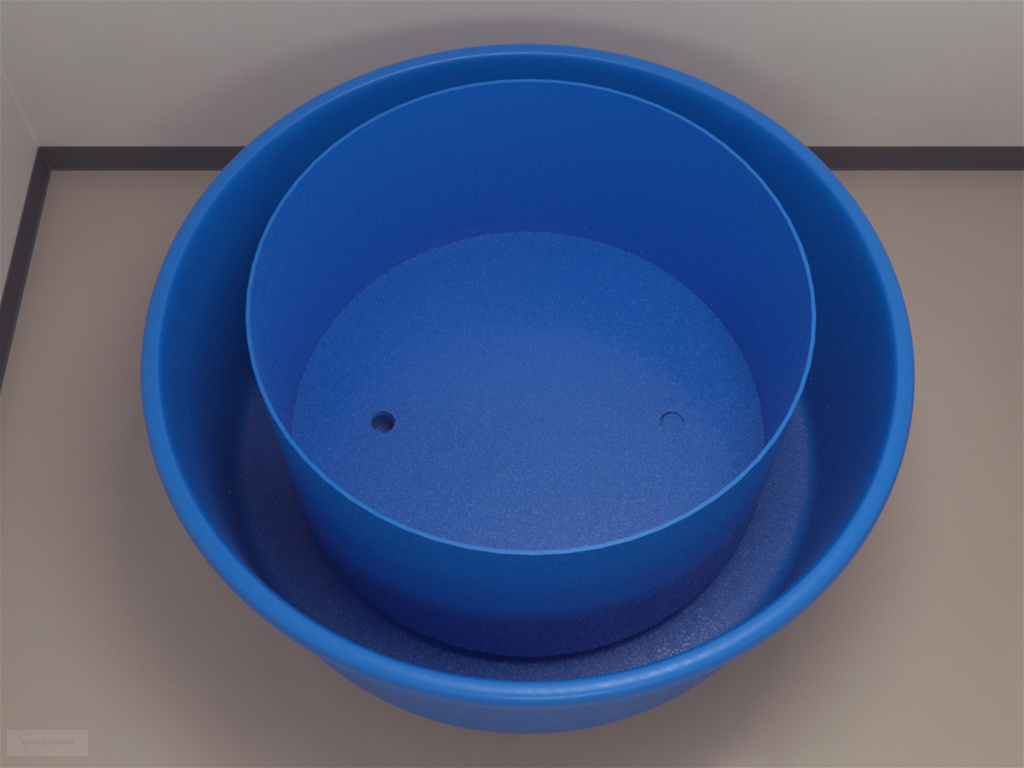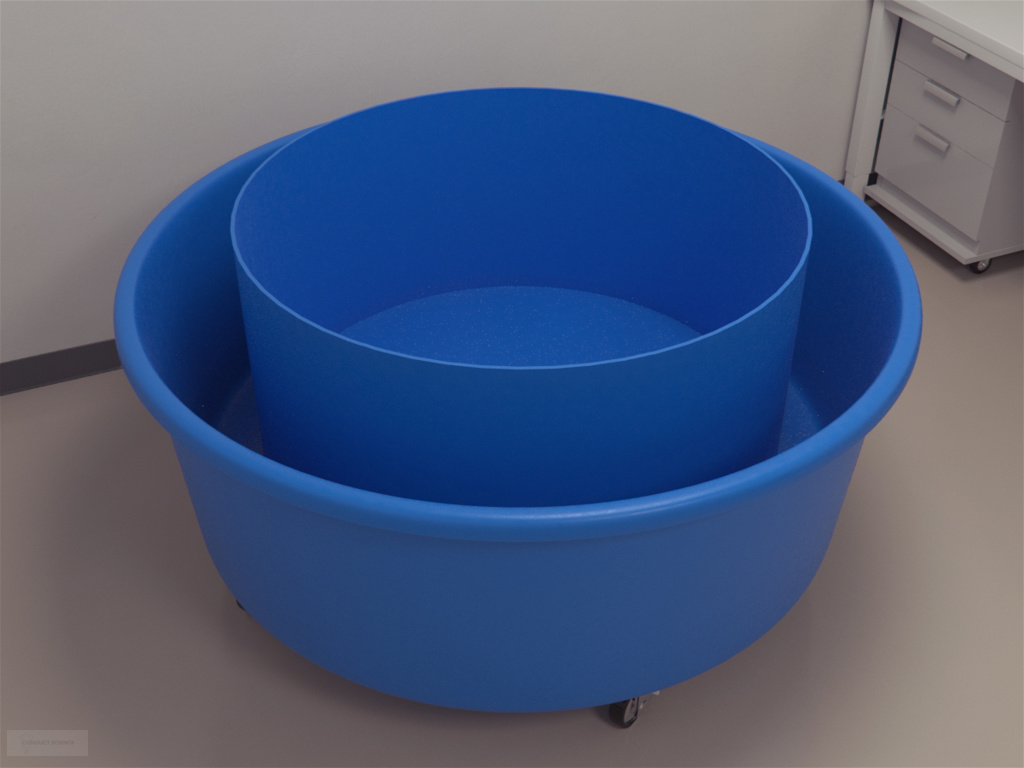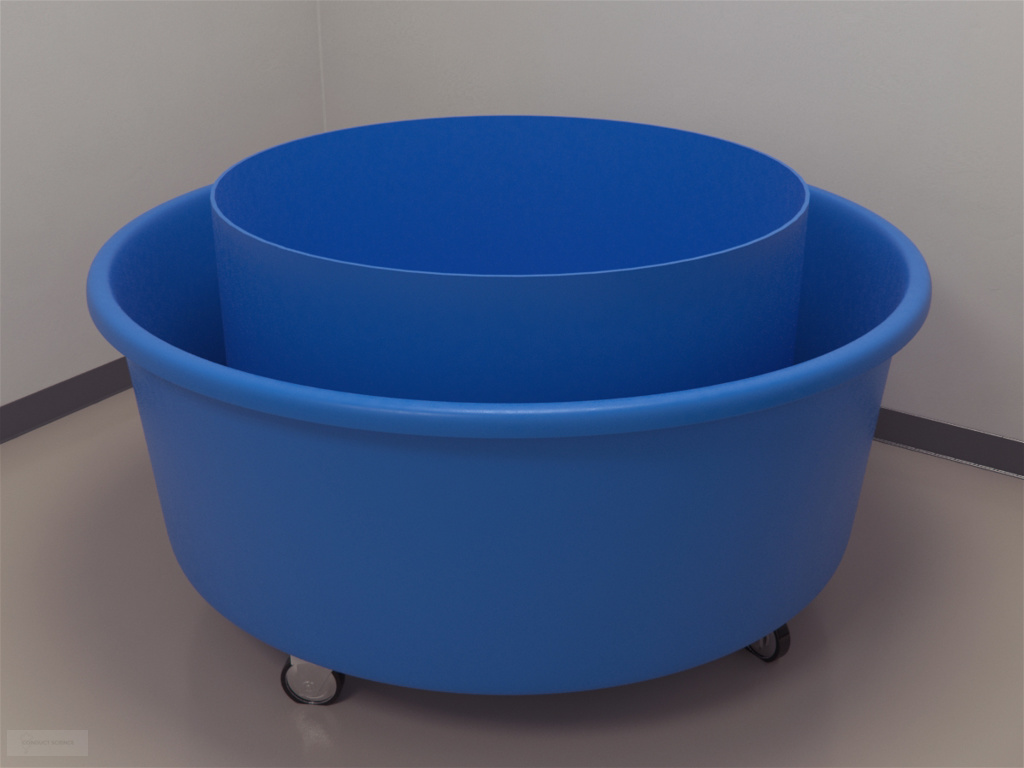The Octopus Round Arena is a maze constructed from a dark gray, round fiberglass
tank with two burrows cut into the bottom of the tank.
It is used in experiments to demonstrate that cephalopods are capable of conditional discrimination thereby extending the limits of invertebrate complex learning.
Octopuses are trained in two maze configurations (the conditions) in which they are required to select one of two particular escape routes within each maze (the discrimination). Conditional discrimination can be demonstrated by selecting the correct escape route in each maze.
Mazeengineers offer Octopus Round Arena. Custom coloring and customization are available upon request.
Price & Dimensions
Octopus Round Arena
$ 2490
+S&H- Diameter of fiberglass tank: 1.46m
- Depth of fiberglass tank: 0.73m
- Diameter of burrows: 8cm
- Distance of burrows from side wall: 14cm
- Height of transparent glass jars: 14cm
- Depth of water within maze: 22cm
Documentation
Introduction
The Octopus Round Arena is used to assess conditional discrimination learning and spatial navigation in cephalopods. In recent years cephalopods, such as octopuses, are being observed to understand the evolution of the neural mechanisms that modulate complex behaviors (Hochner, Shomrat, & Fiorito, 2006; Zarrella, Ponte, Baldascino, & Fiorito, 2015). Since cephalopods occupy a variety of habitats, their behaviors rely on their ability to discriminate between the environment variables or circumstances for successful adaptation (Tokuda, Masuda, & Yamashita, 2014).
The Octopus Round Arena is similar to the rodent Open-Field in terms of using open, bright space as an aversive stimulus to motivate the subjects to find the escape. The arena comes equipped with two burrows that can serve as a safe escape or be blocked off to create a false escape. The maze is placed within a larger outer tank, which allows the opportunity to create different contexts and conditions. In general, conditional discrimination is evaluated by placing the subject within one context and testing its escape behavior within a different context. Additionally, the ability to create enriched environments that mimic the natural setting of the cephalopods can be used to investigate behaviors such as foraging and memory-oriented tasks.
Other apparatuses used in cephalopod-based investigations include the Octopus 3 Choice Maze, the Octopus Y Maze, the Octopus T Maze, and the Cuttlefish T Maze.
Apparatus and equipment
The Octopus Round Arena is an opaque circular tank having a diameter of 1.46 m and a depth of 0.73 m. The bottom of the tank contains two burrows each 8 cm in diameter that are positioned 14 cm from the sidewall. The burrows are equipped with transparent glass jars (14 cm in height) that can be inverted to close off a burrow. The arena is supported within a 1.83 m diameter and 0.76 m deep outer tank. The water level in the tanks is maintained at 22 cm depth through the outer tank. The inner arena has holes at its bottom, which drains the water into the outer unit, which in turn is connected to a filtration system.
Training Protocol
Remove contaminants from the floor of the maze to prevent their influence on task performances. Water should be changed between subjects to prevent the use of any lingering stimuli during the task. Appropriately illuminate the maze arena to encourage escape behaviors.
A recording and tracking system such as the Noldus EthoVision XT can be mounted above the arena to assist with observations.
Conditional Discrimination Task
Create a unique context by placing landmarks and cues in and around the maze. Ensure that only one burrow is kept open while the other burrow serves as the false escape. Gently spin the subject in the carrier container before inverting the container on the stand placed in the center of the arena. Remove the stand and the carrier container from the arena after two minutes have passed to encourage the subject to explore the entire arena. Remove the subject from the maze while it is still in the escape burrow glass once the trial has ended. Repeat the process in a different context, ensuring no landmarks or cues are repeated for the same subject. Switch the escape burrow position in the new context. Alternate trials between the two contexts, until the subject has completed 5 trials in each. Perform one trial per day while maintaining an inter-trial interval of at least 5 hours.
Literature Reviews
Assessment of conditional discrimination learning in octopuses
Hvorecny et al. (2007) investigated conditional learning in octopuses (Octopus bimaculoides) using two different context set-ups in an Octopus Round Arena. Two distinct environments were created using combinations of 5 semi-circular plates glued with various materials, bottom landmark cues (such as algae, a coil of rope, etc.), and wall cues (such as towels, yellow rulers, etc.). It was ensured that the same cues did not appear in both contexts, and maze configurations were not repeated for different subjects. Contexts were alternated for every trial. Subjects were divided into two groups. Group 2 additionally had 5 cm tall plastic rings placed atop the burrows. Group 1 received trials per day with a 5 hours inter-trial interval, while group 2 performed one trial every other day with an inter-trial interval of 30 hours. Subjects performed a total of 10 trials; 5 trials in each context. Conditional learning was evaluated based on the last 5 trials in both groups. Evidence for conditional learning was observed in 4 out of 6 octopuses in group 1 and 2 out of 4 octopuses in group 2. The 6 octopuses, however, did not display reduced escape latency as trials progressed. Individual differences in the time taken to reach the correct burrow varied significantly. Additionally, subjects of both groups were observed frequently visiting the conspicuous landmarks in the arenas. Further, regardless of failure in conditional discrimination learning, the number of errors reduced in the later trials.
Data Analysis
Conditional learning in the Octopus Round Arena is usually assessed in the first 30 minutes of the trial. Successful learning of the task is determined based on the success of the last 5 trials of the maximum 10 trials performed by the subject.
The following observation can be made during the Octopus Round Arena trials:
- Time spent exploring the arena
- Latency to escape
- Time spent exploring the false escape burrow (Errors)
- Time spent in the escape burrow
- Number of incorrect trials
- Number of correct trials
- Time spent idle
- Time spent exploring the landmark/cue
- Number of visits to the landmark/cue
- Number of direct approaches made to the escape burrow
- Number of indirect approaches made to the escape burrow
Strengths and Limitations
Strengths
The Octopus Round Arena utilizes octopus’ aversiveness to brightly lit open spaces to encourage them to explore the arena. The maze’s two tank set-up allows the opportunity to create different environments that enable observation of cephalopod behaviors under different environmental contexts. The arena comes equipped with two-burrows, which can be blocked as required to either create a single escape or no-escape set-up. This allows the assessment of long-term memory retention. The maze’s large size ensures that the escape burrows aren’t within direct reach of the cephalopod once placed in the center of the arena.
Limitations
Octopuses may show reluctance to leave the carrier container. In such cases, introducing a cotton swab dipped in a 10% bleach solution will encourage them to leave the container. In order to eliminate ambiguity in whether or not the subject has touched the closed burrow, rings raised 5 cm above the substrate may need to be placed above the burrows. Activities taking place around the arena may potentially influence the performances of the subject; hence, it is recommended that tasks be performed in a quiet test room with minimal disturbing activities. Constant handling may stress the subject, thereby affecting task performances. Handling should be kept to a minimum, and trials should be appropriately spaced. Factors such as age, gender, weight, and breed can impact task performance. Subjects may display a reluctance to explore the arena.
Summary
- The Octopus Round Arena is used in the assessment of conditional discrimination and spatial learning in the cephalopods.
- The Octopus Round Arena relies on the same principles as the rodent Open-Field. It uses bright light as an aversive stimulus to encourage the subject to explore the maze.
- The arena comes equipped with two burrows consisting of a glass cup. The cup can be inverted to create a false escape.
- The arena’s simple design allows the creation of different environment context by the placement of landmarks and other cues.
References
- Hochner, B., Shomrat, T., & Fiorito, G. (2006). The Octopus: A Model for a Comparative Analysis of the Evolution of Learning and Memory Mechanisms. The Biological Bulletin, 210(3), 308–317. doi:10.2307/4134567
- Hvorecny, L. M., Grudowski, J. L., Blakeslee, C. J., Simmons, T. L., Roy, P. R., Brooks, J. A., … Boal, J. G. (2007). Octopuses (Octopus bimaculoides) and cuttlefishes (Sepia pharaonis, S. officinalis) can conditionally discriminate. Animal Cognition, 10(4), 449–459. doi:10.1007/s10071-007-0085-4
- Tokuda, K., Masuda, R., & Yamashita, Y. (2014). Conditional discrimination in Octopus vulgaris. Journal of Ethology, 33(1), 35–40. doi:10.1007/s10164-014-0414-4
- Zarrella, I., Ponte, G., Baldascino, E., & Fiorito, G. (2015). Learning and memory in Octopus vulgaris: a case of biological plasticity. Current Opinion in Neurobiology, 35, 74–79. doi:10.1016/j.conb.2015.06.012
Request a quote
"*" indicates required fields



